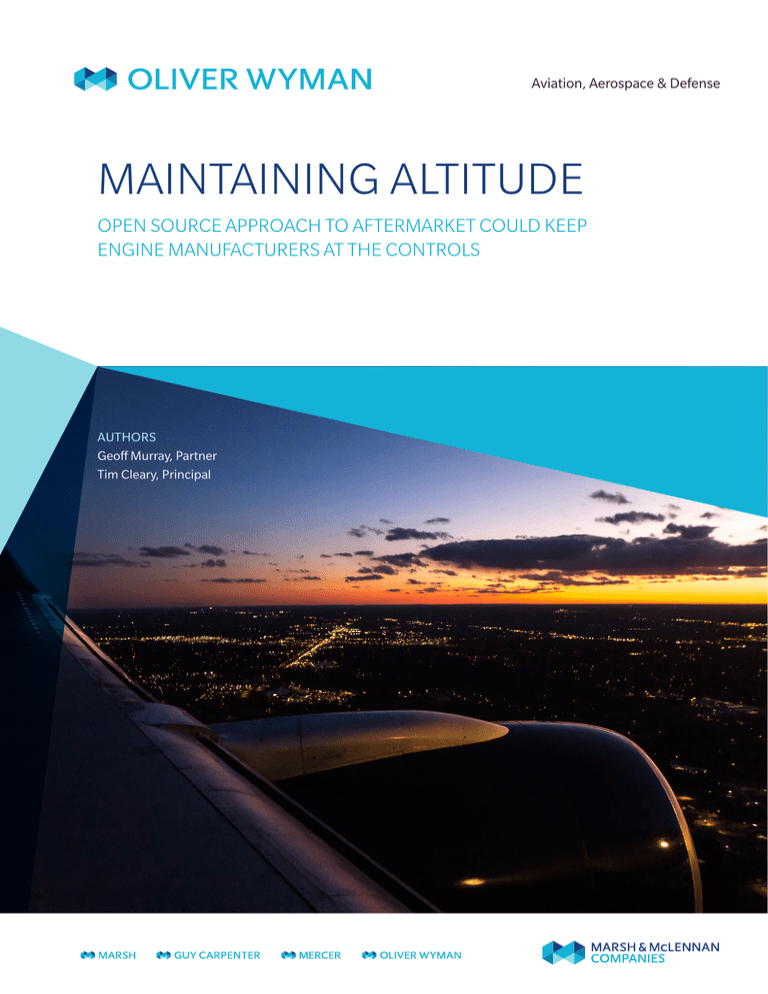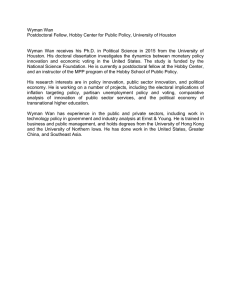
Aviation, Aerospace & Defense
MAINTAINING ALTITUDE
OPEN SOURCE APPROACH TO AFTERMARKET COULD KEEP
ENGINE MANUFACTURERS AT THE CONTROLS
AUTHORS
Geoff Murray, Partner
Tim Cleary, Principal
ABOUT THE SUMMIT
SPONSORED BY
The Global Aerospace Summit is an invitation-only event for C-level executives, senior decision-makers, and
government officials involved with the aerospace, aviation, defense, and space industries.
The 2014 summit brought together more than 1,250 world industry leaders in Abu Dhabi’s St. Regis Hotel, Saadiyat
Island, to discuss the future of these sectors. At the April summit, 62 percent of attendees were C-level executives,
vice presidents, or directors. They came from 52 countries and represented 468 companies.
Copyright © 2014 Oliver Wyman
ENGINE MANUFACTURERS SOAR IN THE AFTERMARKET,
BUT CAN IT LAST?
Aircraft engine manufacturers have developed an aftermarket business model so
successful that some companies have captured as much as a 90 percent share of the work
on their products.
The question now is: How long can this trend endure? As the largest aircraft engine
manufacturers capture more of the aftermarket share, aircraft operators continue to search
for more cost-cutting options. If airline customers vote with their order books,
manufacturers may have to consider a more open-source approach to the aftermarket. If
engine manufacturers don’t give customers what they want, OEMs could be vulnerable in
the long run to disruptive change.
Many companies that long dominated other industries offer cautionary tales for the engine
OEMs. Big-box chains like Wal-Mart have long ruled retail but now must grapple with
Amazon and other online retailers. Local newspapers, once thick with classifieds and local
ads, struggle to compete with Craigslist. Cable television companies are losing some of
their once-captive audience to Internet streaming services.
Three potential disrupters loom on the horizon for engine manufacturers. First, airlines
have already become more sophisticated about considering the total cost of ownership
when purchasing engines, and this could lead to greater customer demands. Second,
additive manufacturing could change the way engines or parts are made, sold, and even
priced. Finally, as the aviation industry develops new fuels and solar aircraft, these
technologies could allow a new engine manufacturer to gain a foothold in the market. The
latter two trends aren’t likely to shake the industry soon, but one or more could challenge
the OEMs’ position in the next decade or two.
If airline customers vote
with their order books,
manufacturers may have
to consider a more opensource approach to the
aftermarket.
The story of engine manufacturers’ increasing presence in the aftermarket industry is wellknown. OEMs moved to a position of strength through two primary means: setting
parameters on airline customers’ access to materials and repair processes and securing
long-term service contracts by offering airline customers predictable maintenance costs at
the point of engine purchase. These methods have allowed OEMs to lock in market share
for years to come. Oliver Wyman has tracked the growth of these services during the past
five years as part of the annual MRO Survey. In the 2014 MRO Survey, 69 percent of airline
respondents said they expect to place engine maintenance with OEMs in the future.
3
AIRLINES FOCUS ON TOTAL COST OF OWNERSHIP
Airlines will likely
demand more control
over maintenance costs
and could begin favoring
engine platforms that
offer greater aftermarket
flexibility.
While OEMs have pushed maintenance contract negotiations further upstream, airlines
have become extremely sophisticated in their understanding of the total cost of ownership
for engines. Now airlines are collecting their own cost and operational data and developing
nuanced perspectives. Airlines are recruiting employees who can conduct this analysis and
are including maintenance professionals on fleet strategy and acquisition teams. As the
influence of this maintenance perspective increases, airlines will likely demand more control
over maintenance costs and could begin favoring engine platforms that offer greater
aftermarket flexibility or at least a broader set of parts, repair, and overhaul options.
One result of such scrutiny of maintenance costs has been airlines’ consideration of parts
manufacturer authority solutions. PMAs, as well as non-licensed and surplus parts, are now
common for some aircraft parts and components. While the PMA industry is growing
overall, it is mostly confined to low-value parts that involve less intellectual property. The
development of PMAs didn’t force a change in the balance of power in the aftermarket, but
it’s an example of a small way that airlines and other industry players have tried to pick away
at OEM dominance.
It is also true that airlines continue to demand the services that independent maintenance,
repair, and overhaul companies provide, as healthy third-party MROs create more choices in
the aftermarket. According to the 2014 MRO Survey, the top strategies among airlines to
cut engine or component maintenance costs are reducing inventory levels, creating
serviceable materials programs, and developing alternate repairs. Of the airline
respondents, 84 percent said their serviceable materials strategy is active or
comprehensive, up from 71 percent the year before.
After surviving the turbulence of recent years, some independent MROs could become the
partners that airlines need. The MRO industry has undergone some consolidation. Those
that remain have become more efficient since driving out significant costs and expanding
their services and product offerings.
Copyright © 2014 Oliver Wyman
ADDITIVE MANUFACTURING IMPACTS THE INDUSTRY
Further in the future, additive manufacturing could become the Netflix of the airline engine
industry. Most MRO Survey respondents agreed that 3-D printing could lower costs and
inventory investment in the next few years. Engine manufacturers could try to block 3-D
printing and might be successful for a time. Or they could embrace the technology and
delight customers by offering a new choice. This would thwart would-be upstart
competitors and turn a potentially threatening technology into a competitive advantage.
Many engine OEMs have already made significant investments in 3-D printing for
manufacturing, and the aftermarket is just a short distance away.
GE is an example of a company embracing additive manufacturing, publicly describing its
work in the area. The company published a photo on its website of a model GEnx jet
engine produced using an advanced 3-D printing technique called direct metal laser
melting. GE also hosts a 3-D printing design challenge that has generated ideas about
engine parts.
NEW TECHNOLOGIES COULD SPARK VISIONARY
COMPETITORS
A third potential disrupter of the airline engine industry — this one even more remote —
could be an upstart engine manufacturer. As the aviation industry develops new types of
fuel, from biofuels to solar, new engine technologies could give birth to a visionary
competitor. An Oliver Wyman analysis shows that several fuels could emerge as viable
alternatives to petroleum-based jet fuel in the coming decades. Biofuels made from natural
oils and animal fats could be economic in the short term; viable ethanol-based fuels could
be developed in the medium term; in the long term, aircraft may be powered exclusively
by electricity.
As the aviation industry
develops new types of
fuel, from biofuels to solar,
new engine technologies
could give birth to a
visionary competitor.
The barriers for these fuels are enormous. They require massive investment and
commitment from companies throughout the aviation industry. Still, many airlines and
manufacturers are motivated to develop alternative fuels, and if new fuels require new
types of engines, this could be a point of entry for a technology company. Such a
development would be years, if not decades, away. Further, incumbent engine
manufacturers are developing their own technologies that could drive the trend.
5
USE MRO PARTNERSHIPS TO MANAGE OPEN
SOURCE ENVIRONMENT
Manufacturers could
move to an open-source
approach by developing
broader, deeper
collaborations with
MROs.
Engine makers could mitigate potential negative repercussions of these trends with a more
open-source approach to the aftermarket. Here’s where MRO partnership could be useful
for developing new technology. Manufacturers could move to an open-source approach by
developing broader, deeper collaborations with MROs. Such partnerships could benefit the
manufacturers in the long term while still allowing them to manage their installed product.
Open-source partnerships could include the already deployed licensing model for repairs
and could extend to development and certification of repairs by outside parties. Such repair
certification could be isolated to a small set of the installed base, most appropriately the
more mature engines, and could include the development of innovative parts, repairs, and services.
Consider the companies in other industries that have been threatened by disruptive change
but have turned that change to their advantage. Cable companies have lost customers to
online streaming services but have responded by upgrading technology and creating better
products. As some utilities fret about losing market share to solar panels, others are offering
services to people who want to install solar. Many big-box retailers are responding to
Amazon by selling a wider selection of items online and using the channel to become more
nimble, cutting store inventory, running quick sales, and marketing directly to customers
with elaborate loyalty programs and email blasts.
In an open-source environment, MRO competitors can be collaborators and new
technology can represent additional revenue. An open-source environment for aviation
engines could offer airline customers greater choice on who performs maintenance work,
with flexible programs that range from OEM-only service, to OEM-and-airline service, to
outsourcing service to independent MROs, with licensing fees and royalties. Deeper
partnerships with MROs could benefit the manufacturers in the long run by allowing them
to offer greater choice and better engine care while still maintaining control of their
installed product. Further, by adding flexibility to the aftermarket business plan now, OEMs
could be better prepared for any technological upheaval the future brings.
Copyright © 2014 Oliver Wyman
RECENT PUBLICATIONS
FROM OLIVER WYMAN
For these publications and other inquiries, please visit www.oliverwyman.com.
MRO SURVEY 2014
AIRLINE ECONOMIC ANALYSIS
Oliver Wyman’s annual survey explores
MRO responses to manufacturer dominance
of the aftermarket. Key themes are new
partnerships, fresh hiring, and 3-D printing.
Oliver Wyman’s popular Airline Economic
Analysis is both an annual reference book of
aviation data and an analysis of key trends.
THE OLIVER WYMAN
TRANSPORT &
LOGISTICS JOURNAL
THE OLIVER WYMAN
RISK JOURNAL VOL. 3
A publication that discusses issues
facing global transportation and
logistics industries.
PERSPECTIVES ON
MANUFACTURING INDUSTRIES
A collection of perspectives on the
complex risks that are influencing
many companies’ futures.
FROM GREEN TO SUSTAINABLE
A collection of viewpoints on challenges
for industrial companies, as well as
opportunities and potential courses
of action.
The fig-leaf approach of “going green” is
no longer enough to show commitment to
sustainability. Companies that
take active leadership on sustainability
will gain competitive advantage and
long-term growth.
ROCKET SCIENCE
GLOBAL RISKS 2014
Will the aviation industry soon feel the
winds of change when it comes to fuel?
Ground transportation is transitioning
to lower-emission fuels. But nearly all
airplanes still run on petroleum-based jet
fuel, due to a lack of commercial options.
Our ninth edition of Global Risks, published
by the World Economic Forum, offers a
snapshot of how more than 700 industry
leaders and experts perceive evolving,
interconnected risks that cut across national
boundaries, the economy, technology,
society, and the environment.
7
ABOUT OLIVER WYMAN
Oliver Wyman is a global leader in management consulting. With offices in 50+ cities across 25 countries, Oliver Wyman combines
deep industry knowledge with specialized expertise in strategy, operations, risk management, and organization transformation. The
firm’s 3,000 professionals help clients improve their operations and risk profiles and accelerate their organizational performance to
seize the most attractive opportunities. Oliver Wyman is a wholly owned subsidiary of Marsh & McLennan Companies [NYSE: MMC].
For more information, visit www.oliverwyman.com. Follow Oliver Wyman on Twitter@OliverWyman.
ABOUT OUR AVIATION, AEROSPACE & DEFENSE PRACTICE
Oliver Wyman’s global Aviation, Aerospace & Defense practice helps passenger and cargo carriers, OEM and parts manufacturers,
aerospace/defense companies, airports, MROs, and other service providers develop growth strategies, improve operations, and
maximize organizational effectiveness. Our deep industry expertise and our specialized capabilities make us a leader in serving the
needs of the industry. Also, Oliver Wyman offers a powerful suite of industry data and analytical tools to drive key business insights
through www.planestats.com.
For more information on this report, please contact:
GEOFF MURRAY
Partner
geoff.murray@oliverwyman.com
CHRIS SPAFFORD
Partner
christopher.spafford@oliverwyman.com
JEROME WEILL
Partner
jerome.weill@oliverwyman.com
MARCUS NEUDEL
Partner
marcus.neudel@oliverwyman.com
Elizabeth Souder edited this report
www.oliverwyman.com
Copyright ©2014 OliverWyman
All rights reserved. This report may not be reproduced or redistributed, in whole or in part, without the written permission of Oliver Wyman and
Oliver Wyman accepts no liability whatsoever for the actions of third parties in thie respect.
The information and opinions in this report were prepared by Oliver Wyman. This report is not investment advise and should be relied on for such
advice or as a substitue for consultation with professional accountants, tax, legal or financial advisors. Oliver Wyman has made every effort to use
reliable, up-to-date and comprehensive information and analysis, but all information is provided without warranty of any kind, express or implied.
Oliver Wyman disclaims any responsibility to update the information or conclusions in this report. Oliver Wyman accepts no liability for any loss
arising from any action taken or refrained from as a result of information contained within this report or any reports or sources of information referred
to herein, or for any consequential, special or similar damages even if advised of the possibility of such damages. The report is not an offer to buy
or sell securities or a solicitation of an offer to buy or sell securities. This report may not be sold without the written consent of Oliver Wyman.



